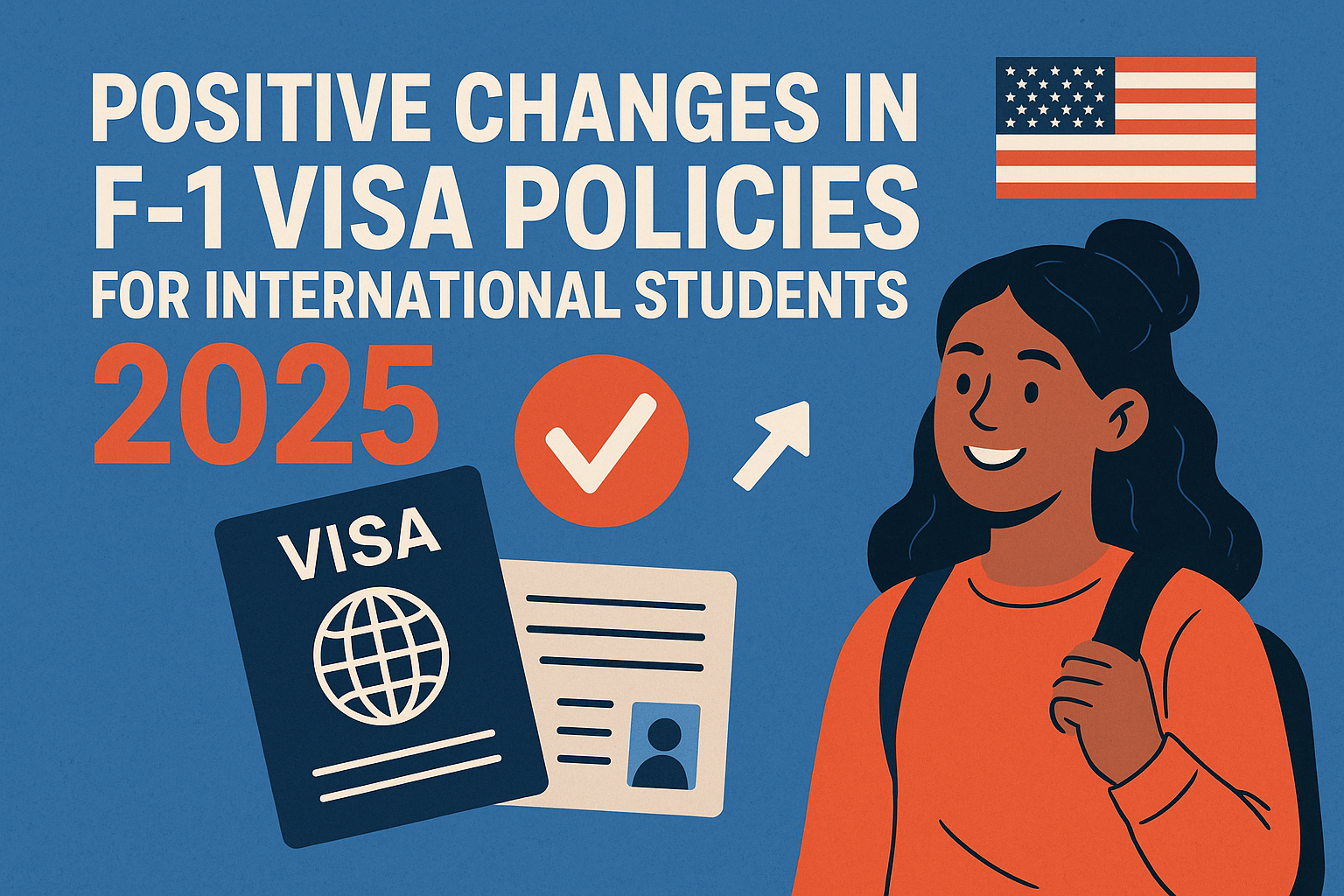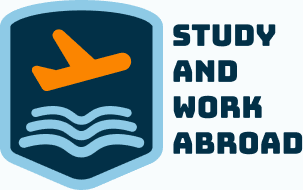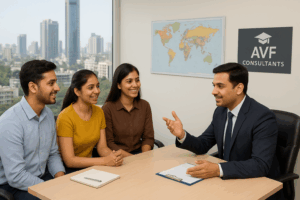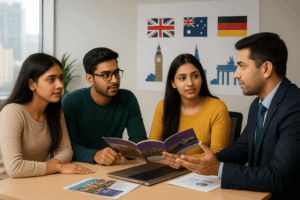Call Us:+91-9920234749, +91-9833420909 info@studyandworkabroad.in

Positive Changes in F-1 Visa Policies for International Students in 2025
The United States has long been a top destination for international students, offering world-class education, a diverse cultural experience, and unparalleled career opportunities. As of 2025, a series of reforms to the F-1 visa program are making the journey to study in the U.S. even more accessible and beneficial for global learners—especially Indian students. These positive changes reflect the U.S. government’s commitment to attracting international talent while ensuring transparency, efficiency, and long-term opportunities.
In this blog, we’ll explore how the new F-1 visa rules are evolving, what benefits they bring, and how you can take full advantage of them.
1. What is the F-1 Visa and Why It Matters
The F-1 visa is a non-immigrant student visa that allows international students to pursue academic studies at accredited institutions in the U.S. This includes undergraduate, postgraduate, and language training programs. It’s the most commonly issued visa for study purposes and plays a critical role in shaping the global mobility of students.
Holding an F-1 visa gives students access to:
- Full-time education at U.S. institutions.
- Limited on-campus employment.
- Practical training options like OPT (Optional Practical Training) and CPT (Curricular Practical Training).
- Cultural exchange and global exposure.
With the 2025 changes, the F-1 visa program is becoming even more student-friendly.
2. Key Positive Changes in F-1 Visa Policies (2025 Update)
Let’s take a closer look at the recent reforms and how they positively impact international students:
Faster Visa Renewals
One of the most student-friendly updates is the streamlined process for visa renewals. Students reapplying for an F-1 visa within one year of expiration can now benefit from:
- Reduced paperwork.
- Shorter processing times.
- Fewer in-person appointments.
This is a major relief for students wishing to continue advanced degrees or extend their stay for OPT-related employment.
Expanded Opportunities for STEM Students
STEM (Science, Technology, Engineering, and Mathematics) programs continue to receive strong support:
- OPT extensions for STEM graduates remain a highlight, with up to 3 years of post-study work authorization.
- Students in STEM fields now have clearer pathways to H-1B work visas, giving them a longer career runway in the U.S.
Enhanced Support During School Closures
In the past, sudden institutional closures left many international students stranded. The new F-1 policy offers:
- Clearer guidelines and transfer options for affected students.
- Support from the SEVP (Student and Exchange Visitor Program) to maintain visa status during transitions.
This adds a layer of security for students choosing smaller or newer universities.
Optional Practical Training (OPT) Remains Strong
Despite increased scrutiny, OPT continues to be a valuable opportunity:
- International students can work in their field of study for up to 12 months post-graduation.
- STEM students enjoy a 24-month extension, making it 36 months in total.
- Career services offices in universities are also more engaged in supporting visa-compliant employment opportunities.
Faster Processing for High-Priority Applicants
High-performing students or those admitted to highly ranked institutions may now benefit from faster approvals in both first-time visa applications and renewals.
Transparent Guidelines on Transition and Immigration Pathways
Students now have better clarity on:
- Transitioning from F-1 to H-1B (work visa).
- Eligibility for permanent residency pathways (green card), though dual intent is still restricted.
- Legal timelines and what actions to take post-graduation.
3. Eligibility Criteria for the F-1 Visa (2025)
To successfully apply for an F-1 visa, you must meet the following updated requirements:
- Admission to a SEVP-Certified Institution: Your chosen university must be authorized to host international students.
- Proof of Financial Stability: You must show that you can afford tuition, accommodation, and living expenses.
- English Language Proficiency: Tests like IELTS or TOEFL are usually required.
- Non-Immigrant Intent: You must initially demonstrate an intent to return home after completing your studies.
- Full-Time Enrollment: F-1 visa holders must maintain a full-time academic load each semester.
4. Careers After Graduation: Stronger Job Prospects Than Ever
The new F-1 visa policies have opened stronger career pipelines, especially in fields like:
- Information Technology & AI
- Data Science & Analytics
- Healthcare & Life Sciences
- Engineering
- Business & Finance
Thanks to the extended OPT duration, Indian students can now gain valuable U.S. work experience, often leading to employer sponsorship for H-1B visas.
Also, many U.S. universities now offer integrated co-op programs, internships, and CPT options that allow students to work while studying—legally and with institutional support.
5. Comparison: Old vs. New F-1 Visa Rules (At a Glance)
| Aspect | Old Policy | New Policy (2025) |
| Visa Renewal | Lengthy, paper-heavy process | Faster renewals within 12 months of expiration |
| OPT/CPT Approval | Fewer requirements | More documentation, but STEM OPT stays strong |
| Monitoring Student Progress | Annually or upon request | Real-time tracking of attendance and academic status |
| Work Authorization | Limited oversight | More formalized and regulated, but still accessible |
| Grace Period After Graduation | 60 days | May be shortened—students must act quickly |
| School Closure Guidelines | Unclear, confusing | Transparent and structured response plan |
| Dual Intent Flexibility | Loosely interpreted | More scrutiny but clearer communication of rules |
6. Tips for Indian Students Applying Under New F-1 Rules
If you’re planning to study in the U.S. under the new F-1 visa policy, here are a few expert tips:
- Apply Early: Due to increased documentation and background checks, it’s wise to start your visa process 3–6 months before your program begins.
- Stay Connected With Your DSO: Your university’s Designated School Official (DSO) is your primary contact for compliance and immigration help.
- Plan for OPT Early: Start networking and applying for internships/jobs before graduation.
- Keep Documentation Ready: Ensure all academic transcripts, financial proof, test scores, and SEVIS forms are updated and easily accessible.
- Understand Your Exit Plan: Be aware of your grace period, and plan whether you’ll return, seek work, or transition to another visa.
7. Why Choose the U.S. in 2025 and Beyond
Despite current roadblocks in applying for the F-1 visa and global competition from countries like Canada, the UK, and Australia, the U.S. still remains a top choice for Indian students due to:
- Quality education and research facilities.
- Wide range of academic programs and scholarships.
- Practical training and work experience opportunities.
- A strong Indian diaspora community.
- Long-term career and migration potential.
With the positive F-1 visa changes now in place, the U.S. is more accessible and rewarding than ever before.
FAQs About F-1 Visa Updates
Q1. Has the grace period after graduation changed?
A: It may be shortened from the usual 60 days. Students should confirm with their DSO and plan early for OPT or further studies.
Q2. Can I still apply for OPT under the new rules?
A: Yes, OPT remains available, especially for STEM graduates, though documentation and approval timelines may be stricter.
Q3. Are renewals easier under the new policy?
A: Yes, renewals are faster if applied within one year of expiration. First-time applicants will still undergo full processing.
Q4. Will school closures affect my visa?
A: No. The updated rules provide clear guidance on transferring institutions and maintaining visa status.
Q5. Is transitioning to H-1B still possible?
A: Yes, though the rules around dual intent are stricter. Working with legal experts or university advisors is recommended.
Conclusion: A Promising Future for F-1 Students
The 2025 updates to the F-1 visa policy present a balanced approach—enhancing both opportunity and accountability. While students are expected to follow clearer regulations, they are also rewarded with faster processing, more work opportunities, and greater transparency in immigration pathways.
For Indian students aiming to build a global career, now is an excellent time to consider studying in the U.S. With proper planning and expert guidance, you can unlock the full potential of these new F-1 visa reforms.



